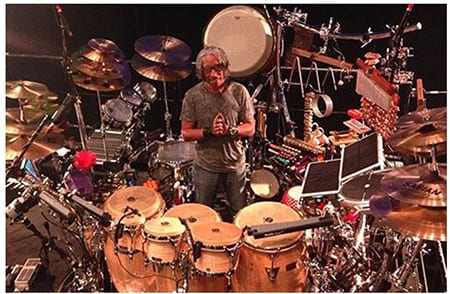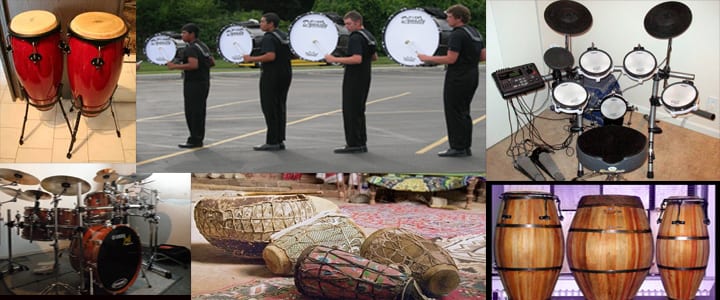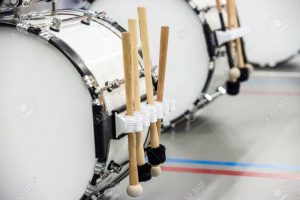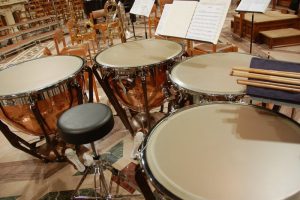If you’re interested in learning drums, you’ve probably learned a little bit about the drums that make up a drum kit. When it comes to percussion instruments, however, there are so many other different types of drums.
The world of drums and percussion is enormous, and it’s such an intriguing ground for exploration. This article describes various types of drums, from small drum to large drums but it’s by no means an exhaustive list, as that would be a very lengthy write-up!
This article, however, will capture your interest, and perhaps prompt you to venture out and add some new sounds and instruments to your drumming adventure. Here’s a table of contents for finding your way around this guide:
How Many Types of Drums Are There?
There are countless different drums instrument types and variations for you to choose from. In general, however, drums can be categorized into one of the following groups:
- Drum sets
- Hand drums
- Frame drums
- African drums
- Marching band drums
Keep reading to learn about the many types of drums!
Types of Drum Sets
Let’s begin our journey on some familiar ground, and explore some different types of drum sets, to help explain each type we have included drums image for each category.
Acoustic Drum Set
You’re probably most familiar with this type of drum set, but there are lots of variations in size and configuration.
In most acoustic drum sets, you will find drums such as
- Snare drum – This is placed in the center of the drummer and offers a distinctive cracking sound when struck. There are several snare drums types, each of which can be added to create a different style of music.
- Bass drum – This can be operated with a beater or kick pedal.
- Floor tom – the floor tom is the second-largest drum in an acoustic set, second only to a bass darm. It has a low booming sound with a deep tone.
- Rack tom – This type of drum has an open, resonating sound with a defined tone.
Most acoustic sets will also contain a mash-up of other equipment like pedals, percussion instruments (like cowbells and tambourines) and cymbals.
Acoustic drum sets can be further classified as follows.
- Power/Rock: These sets generally have 12, 13, and 16-inch toms, and a 22 x 18-inch bass drum. The snare may vary in size, but it’s typically 5 ½ or 6 x 14″. They have a deeper tone and more volume due to their larger sizes.
- Fusion: These sets are typically sized as follows: 10, 12, and 14″ toms, with a bass of either 20 or 22 inches x 18 inches. They aren’t quite as thunderous as their rock-sized counterparts, but they allow for quicker playing due to their faster response.
- Jazz Drums: These are supposed to be quick and light, and the toms usually have the same diameter as the fusion toms—but with shallower depths, and the bass drum is markedly smaller; usually 18” x 14”. Some well-known brands include Gretsch, Yamaha, Ludwig, Pearl, Sonor, Mapex, DW, OCDP, Pacific, Tama, and Crush. There are also several options for variations in configuration.
- Virtual and Electronic Drum Kits: Electronic drum sets give you access to an unbelievable library of sonic options. Over the years, their “brains” have become more advanced. You have a wide array of sounds with samples from top-of-the-heap kits. Additionally, you have capabilities of percussion and beyond. These kits are available in range from very basic to professional. They have the ability to work with interactive software and apps to provide everything from tutorials to packs of sounds. E-kits are very cool and a lot of fun. If you’re interested in buying an E-Kit, I recommend checking out Roland, Yamaha, and Alesis.
- Triggers: I would be remiss not to visit the world of triggering, which allows you to reap the benefits (feel and resonance) of your acoustic kit and the brains of the V-kit by adding triggers, which touch the heads of your drums and relay signals to a module (brain) to add to your sonic capabilities. They can be particularly handy in recording/live applications to enhance and clarify your sound or to provide backing tracks.
- Auxiliary Drum Sets: These are a complete playground for the adventurous. They can include elements from the whole spectrum: drums, bells, blocks, triangles, chimes, etc. Auxiliary drum sets are for solo applications or bands, often in addition to a drum set.
 See Also: The Best Brands for Drum Sets
See Also: The Best Brands for Drum Sets
Types of Hand Drums
Acoustic drum sets aren’t the only types of drums out there.
Hand drums are also common.
While you play hand drums by hand, some work well with mallets or “tippers.” They come from across the globe; each type of hand drum has a distinctive pattern and playing technique.
Here are some popular types of hand drums to add to your line-up.
Congas
These tall, Cuban drums typically come in groups of two or three. Conga drums come in three different sizes: quinto (small), conga/tres dos (medium), and tumba (large).
Bongos
Bongo drums are Afro-Cuban, small, and often played in conjunction with the congas. If you’re bilingual, you have an advantage when it comes to pronouncing their names! The smaller drum is the “macho” and the larger drum is the “hembra.”
Tabla
You can play these Indian drums with the heels of your hands and your fingertips. The small, wooden drum is the tabla, and the larger, metal drum is the dagga.
Cajon
A box-shaped instrument, this type of drum is a percussion instrument from Peru. It’s often used in live acoustic performances and can be struck with a hand or with a brush or various types of drum sticks. What’s really unique about this drum, however, is that you sit on it while playing!
Frame Drums
This is actually a pretty broad family, with different types of drums from all over the world.
Pandeiro
A Brazilian instrument played with the fingers, thumbs, and palms on the head, along with the fingers/thumbs on its platinelas (jingles).
Tambourine
A close cousin to the pandeiro, the tambourine is from various regions, and has smaller jingles—called zils. There is much more to playing this instrument than mot people think.
A tambourine may or may not have heads, and it may or may not be tunable. A tambourine can have single or double rows of jingles. There are many other similar drums from different parts of the world.
Bodhran
This Irish/Celtic frame drum can be played by hand or with various types of beaters, known as tippers. Bodhran drums may or may not be tunable.
Goblet Drums
This is a family of drums that get their name from their shape. A darbuka, which hails from the Middle East, is an example of a goblet drum.
Types ofAfrican Drums
This is another broad family of hand drums – here are some common types of African drums you can play.
Djembe
The djembe is a very popular hand drum from West Africa. It may be rope-tuned or mechanically tuned (Westernized). They may have goatskin heads (shaved or not) or synthetic heads.
Talking Drum
To play the talking drum, place it under your arm and squeeze the rope while you hit the drum. Use a striker to alter the pitch.
Udu
The udu is a clay-based drum from Nigeria. Variations of the udu may have one or two chambers.
To play the udu, strike the larger hole with your palm, or use your fingers on the body.
Some other African drums worth looking up are the dunun, bendir, junjung, and bougarabou.
Types of Marching Band Drums
Marching band drums supply the voice for the band. Here are some of the most commonly used types of drums in a marching band, most of which, can be mounted on harnesses or stands.
Related Article: How to Become a Drum Major
Marching Snare
The marching snare drum is quite different than the snare used on the drum set. It’s much deeper and the head is made of Kevlar. The marching snare can hold very high tension.
Multi-tenor
The multi-tenor drums come in several configurations, most commonly sets of four to six. They’re the higher pitched melodic voices of the battery and are typically played with sticks or mallets.
They may have small, tightly tuned accent drums, known as spocks or shots (among other names).
Bass Drum
The bass drums are the lowest pitched drums in the battery and come in several sizes that allow for melodic runs along the line.
Front Ensemble
The front ensemble/pit is stationary on the field and has a wide variety of percussion instruments like the marimba, xylophone, glock, vibes, bass drum, drum set, and timpani, as well as hand/frame drums and auxiliary instruments.
Types of Orchestra Drums
Orchestras use many types of drums to add intense layers and a unique dynamic to a piece. There are all kinds of percussion instruments that can be used in addition to these varied types of drums, including wood blocks, guiros, claves and wind chimes.
Here are some of the most common orchestra drums.
Concert Snare Drum
The concert snare drum helps keep the rhythm going in an orchestra. These drums have short, snappy beats and can be played in a militaristic style, too.
Concert Bass Drum
The concert bass drum is usually played standing up, typically with a large mallet. It’s larger than a typical bass drum that you might find in a regular drum set – usually, it will be 40 inches or so in diameter.
Timpani
The timpani is one of the most famous types of orchestra drums. A large copper drum, it is tuned with a foot pedal and struck with a mallet to produce a very full, resonating sound.
If you’re new to tuning drums, you may find it helpful to check out this video on tuning drums of all types:
What is Each Drum Called?
While some people recognize three main types of drums – a bass drum, snare drum, and tom – the reality is that drum sets can contain countless different pieces to create a truly unique sound.
From bass drums to kick drums, cymbals to timpanis, and everything in between, it’s easy to see that there are many drums out there for you to choose from when you’re learning how to play percussion.
We have covered several different types of drums, but we have still only scratched the surface of the world of percussion instruments. From drum sets, hand drums, percussion drums, and marching band drums, there’s something for every aspiring musician.
What types of drums do you want to learn about? Let us know in the comments below!
 Post Author: Tracy D.
Post Author: Tracy D.Tracy D. teaches percussion and drum lessons in Edmond, OK. She has been playing the drums with various bands for more than 13 years and earned her Bachelor’s in Music Education from Oklahoma Christian University. Learn more about Tracy here!
Maile Proctor




